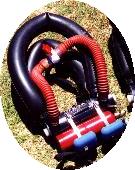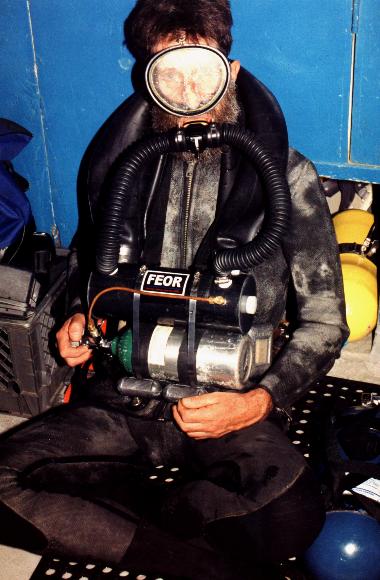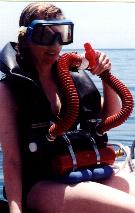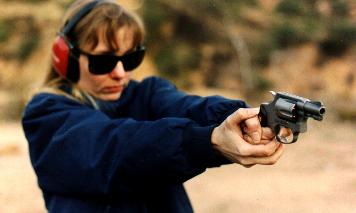| Crestline
Experimental
Dive
Unit
|
|||||||||||||
|
FIELD EXPEDIENT OXYGEN REBREATHER |
|||||||||||||
| Oxygen
cylinder
The oxygen cylinder is placed below absorber canister housing assembly and the 16 pounds of lead counterbuoyancy weights. The 248 litter (optional) aluminum, non-magnetic cylinder has a charging pressure of 2015 psi. (The Standard cylinder is a small 31 liter steel one-use disposable tank. But why would any real man want one so little?) Regulator
unit
The
by-pass valve
The
dosage unit
|
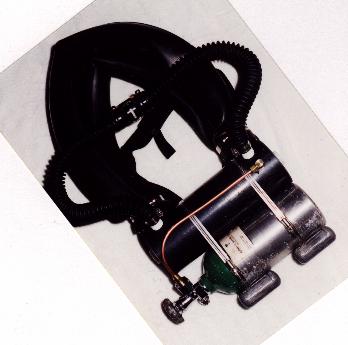
FEOR (ExCap) with optional 248 liter aluminum cylinder.
Standard FEOR with 31 liter steel cylinder.
Diver Operating the Dosage Unit,
Jane above and below the water with her Standard FEOR.
Jane Says: "Get Your Hands Off My FEOR,
|
The
relief valve
There is no relief valve, just wee-wee in your wet suit. (A a little joke son,... just a little joke.) Though there is no mechanical relief valve, an overpressure condition IS relieved by anatomical means. Various built-in body orifices are utilized by the diver to vent excess gasses that might develop. The nares portal of the nasopharyngeal apparatus is considered most convenient, most safe and most socially acceptable. The Ab-Oral (anal) orifice can also be used in certain emergency situations without much long term pathology. The consumption of knockwurst or beans prior to diving facilitates this route of excess gas removal. Warning: This manufacturer does not recommend the tympanic route of venting excess gas. The buoyancy control unit With this unit the user can select an almost infinite number of settings for more or less buoyancy. The custom made unit includes counterlungs that are engineered to to provide approximately 3 pounds of positive buoyancy when the counterlung is completely inflated. This will correspond to a 1.5 liter volume in excess to the individual divers Vital Capacity. In normal use the divers Tidal Volume set point can be adjusted resulting in a change in overall buoyancy. The breathing bag The Dual Horseshoe shaped breathing bags are placed behind the neck, over the shoulder and in front of the divers chest. This achieves low breathing resistance. Breathing bags are made from puncture resistant material, not unlike the inner tubes found on the front wheels of Harley Davidson Motorcycles. Recently an abundant amount of slightly used steel belted radical-radial "breathing bags" from the Brigstone-Firestone "breathing bag company" have become available for those operations where close quarter hand to hand engagements are anticipated, and maximum puncture resistance is needed. (Warning: do not exceed high speed, overloading, extremely high temperatures and inflation pressures in the 26 psi range while using these specialized breathing bags.) The absorber unit The absorber unit consists of an ABS Sewer Pipe. Through extensive engineering and precision machining a Value Added Transformation results in the Highly Effective and Very Expensive absorber housing. By naturally insulating the CO2 absorbent from the surrounding cold water with this non-metallic low thermal conducting material, the duration time is almost independent of water temperature, though not completely. It gives superior utilization of the CO2 Absorbent and a low breathing resistance via its highly acclaimed Axial Flow Design. The absorber canister can be prepackaged, stored, and forgotten for a long time, though this practice is highly frowned upon. The unit should be prepared immediately preceding its operation , ensuring that the oxygen is of adequate quantity and quality, and the CO2 absorbent is of proper moisture content. (May your gas be plentiful, and may your powder be dry.) |
|||||||||||
| Mouthpiece
When properly placed, the unidirectional Mushroom valves in the mouthpiece ensures low rebreathing resistance. The Dive-Surface-Valve (DSV), depending upon design, can be shut off to prevent leakage of water. Note: some DSVs require two hands (additional strength) to operate. DSV operation testing will be conducted in order to check that the DSV selected is one that the individual user can actually handle. Harness
|
|||||||||||||
|
Specification Height Width Length Weight with oxygen and soda lime Cylinder volume: 31 to 248 liters useable* Cylinder material: Steel or Aluminum* * Will vary depending upon specific configuration desired. Duration
The
FEOR set has been tested by BOB, JANE, ERICK & JOCKO of the Crestline
Experimental Diving Unit (CEDU)
All specifications subject to change. |
|||||||||||||
